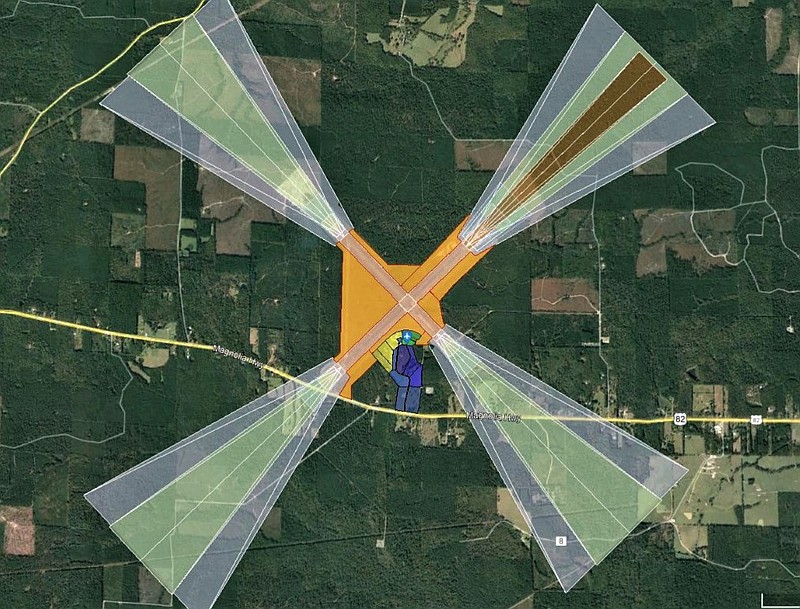A federal permit has been granted for the use of drones in designated areas at South Arkansas Regional Airport at Goodwin Field.
SARA manager Johnathan Estes applied for and was recently granted a Certificate of Waiver or Authorization from the Federal Aviation Administration to fly drones, or sUAS (small un-manned aircraft systems), on the airfield.
Estes, who is licensed to fly drones for commercial use, applied for the waiver Aug. 24 and he learned that it was accepted by the FAA on Sept. 9.
He has already applied for an extension, saying that the waiver is only good "from month to month" and the certificate expires Sunday.
With the Certificate of Waiver or Authorization, Estes said he may now use drones to serve a number of functions at SARA, including tracking wildlife, performing building inspections and shooting videos and photos to help market and promote SARA and Southern Express Airways, the area's Essential Air Service, commercial carrier.
For safety reasons, drones are typically not allowed to be flown within five nautical miles of the airfield. Estes said the federal regulation also applies to airport managers.
Thus, as a side project, he began the process of obtaining a Part 107 license to become a drone pilot under the FAA's sUAS rule, which certifies that the licensee understands the regulations, operating requirements and procedures for safely flying drones.
Licenses are required for the commercial use of drones but not for recreational use -- a practice in which Estes has engaged for a while.
After securing the Part 107 license to fly drones at SARA, Estes applied for the Certificate of Waiver or Authorization, which spells out the allowances and limitations of how drones are to be used at the municipal airport.
Estes worked with the FAA's Un-manned Aircraft Systems Integration Office in Washington D.C. to help him navigate the application process.
"Drones are just now being widely recognized, which is why the FAA is starting to clamp down on drones," Estes said. "As drones are incorporated into the national airspace system, the more (the FAA will) open up and the more it will clamp down on restrictions."
He said Keith Stokes, of the FAA's Un-manned Aircraft Systems Integration Office, offered helpful advice on how to write and revise the application.
For instance, Estes said he initially included a request to use drones to inspect Precision Approach Path Indicators at SARA.
PAPIs are visual aids that provide information to guide pilots and help them acquire and maintain the correct approach when landing aircraft.
"In my original request, me and (Stokes) both agreed that what I was asking for required a lot more planning than what I had originally done," Estes said.
He noted pros and cons for using drones to perform visual checks on PAPIs, explaining that using drones would be quicker and more cost efficient, rather than having to fly up in a plane, and the runways at the airport would have to shut down during the drone check.
However, Estes said the obtaining the CWA from the FAA "is also a step in the right direction towards getting approval for other waivers or authorization" in the future, including performing flight checks (visual checks) on the PAPIs and other possibilities.
Estes said the Saline County Office of Emergency Management recently purchased a drone with infrared/thermal imaging capabilities to help fight fires.
"It can help with fighting forest fires, or if firefighters couldn't figure where the hot spots of a fire are, they can use the infrared device on the drone to see through the smoke and find the hot spots," Estes said, adding that he has spoken with Fire Chief Chad Mosby about the matter.
The FAA authorization allows for the use of drones in designated areas at SARA with restrictions, such as height requirements, that are specific to each area.
Estes said he is not allowed to fly above 100 feet AGL (above ground level) in any zone.
Drones may only be used during the period between civil sunrise and civil sunset (30 minutes prior to sunrise and 30 prior to sunset.
Areas along the fence line at the airport, with the exception of runway approaches, are permissible, Estes said.
He is not allowed to fly drones if the cloud ceiling is less than 1,000 feet AGL and horizontal visibility is less than three feet.
"So, I have to be able to see 1,000 feet up and three feet across the (airfield)," he said.
Estes may request additional waivers, when needed, by contacting the Air Route Traffic Control Centers in the FAA's regional offices in Fort Worth.
By securing the CWA, Estes said the groundwork has been laid for anyone else who would like to request a waiver to use drones at the municipal airport and boost their chances for approval.
"The authorization only applies to me. It lays the building blocks and foundations for future airport managers or anyone else who wants to try to do this," he said.
"They'll have to apply for their own authorization but I've pretty much invented the wheel," Estes continued. "If someone wants to do this in the future, they pretty much have a template that says here's the operations manual."
